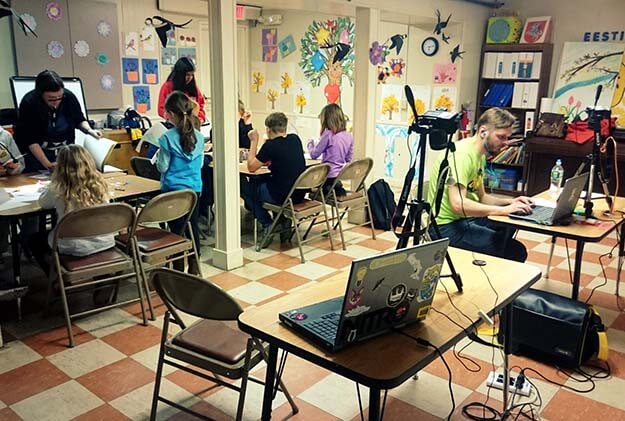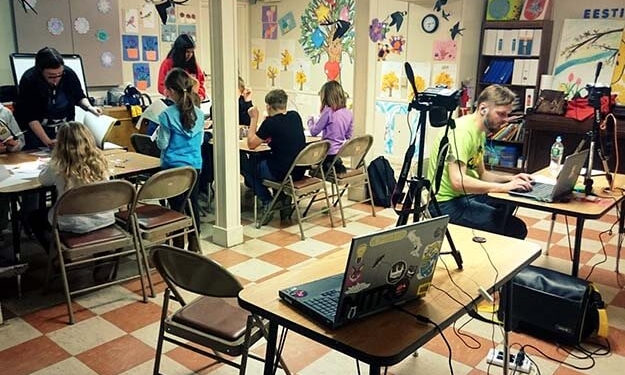 Animation Generation hosted its first US workshop at the Lakewood Estonian House in Lakewood, N.J. on Saturday, May 7, 2016. Photo by Kreeta Käeri
Animation Generation hosted its first US workshop at the Lakewood Estonian House in Lakewood, N.J. on Saturday, May 7, 2016. Photo by Kreeta Käeri
In a project funded by a grant from the Estonian Ministry of Culture and the Estonian American National Council with the aim of bringing Estonian-American children’s connections to their families’ homeland to life, the Animation Generation team held its first three workshops in Lakewood, N. J. and New York City on May 6 and 7, creating stop-motion animations with a total of 33 Estonian-American children.
The Estonian community in Lakewood centers around a trio consisting of the Estonian House, the church belonging to the Lakewood Holy Ghost (Pühavaimu) congregation, a member of the Estonian Evangelical Lutheran Church, and the Estonian Archives in the U.S. (EAU). The Estonian community there is one of the most organized in the US, with weekly events and church services. Pastor Thomas Vaga, who came to the United States in 1949, met with the Animation Generation team and spoke of the changing needs of the community.
Vaga explained that the Estonian community in Lakewood began as a refugee community, and there comes a time, as in every such community, when a decision must be made regarding whether to continue services only in Estonian, even as such services are needed less and less, or move into two languages.
The church now offers services in English once a month, even as it remains a bastion of Estonian identity in the coastal state. The church building itself was designed by an Estonian architect and built from stone from an Estonian quarry. According to church record, the massive front altar painting “…depicts the fate of the Estonian people, wherein Jesus Christ has come to their aid and provided strength to those deported to Siberia, freedom fighters suffering in prison camps, refugees escaping through stormy seas, and those who escaped to a new country and freedom.”
The Estonian archive, located directly next door to the church, houses not only written records, but also things such as artwork, textiles, ethnographic items, medals, and memorial stamps. Displayed items include walls of framed medals from Estonian high schools, handcrafted folk costume pieces, and even 1970s-era Barbie dolls painstakingly dressed in ethnic styles from all over Estonia. The pastor’s wife, Airi, explained that these pieces were made from memory during a time when refugees believed that Estonia might truly someday be no more.
The main-floor bar at the Lakewood Estonian House, located a few miles away, doesn’t serve Saku, but there is enough activity to go around anyway. There are meetings and classes for Estonian Boy Scouts and Girl Guides, senior clubs, and special occasion events, like the Mother’s Day meal held on Sunday.
Saturday’s animation workshop, much anticipated by local Estonian children, took place in the building’s basement room, where the local Lithuanian School rents space alongside the twice-monthly Estonian School classes. The kids dove right in, creating two stop-motion animation works and a fun pixelation wherein all of the children appeared to climb into a box which was mailed to Estonia by Helica DeShaw, the newly elected President of the Lakewood Estonian Association (LEÜ).
Animation Generation Takes Manhattan
The reception was equally warm at the New York Estonian House on Sunday, where due to demand, two workshops were held for the children.
“I think workshops like this are an excellent idea, and we were really excited to take part in it,” said Paul Kuldkepp, a parent of one of the participants of the animation workshop in New York. “My son Oskar has an iPad and has done some stop-motion animations at home. He had so much fun in the first session that he asked to participate again in the second one. There are things like the Estonian opera that come here for adults, but workshops for the kids that support a direct cultural link are much more rare. This allows kids to do stuff that’s hands-on. After this, you can introduce things like [award-winning Estonian cartoonist] Priit Pärn, and you’re not trying to interest kids in something they have no experience with.”
In addition to screening the animations and pixelations made by the children themselves, the Animation Generation team also screened several short films, including Ülo Pikkov’s “ADA + OTTO,” which the children proclaimed was “Sooooo cute!”
The three-person team’s next stop will be at the Chicago Estonian House in Riverwoods, Ill.
Aili Sarapik / ERR News













